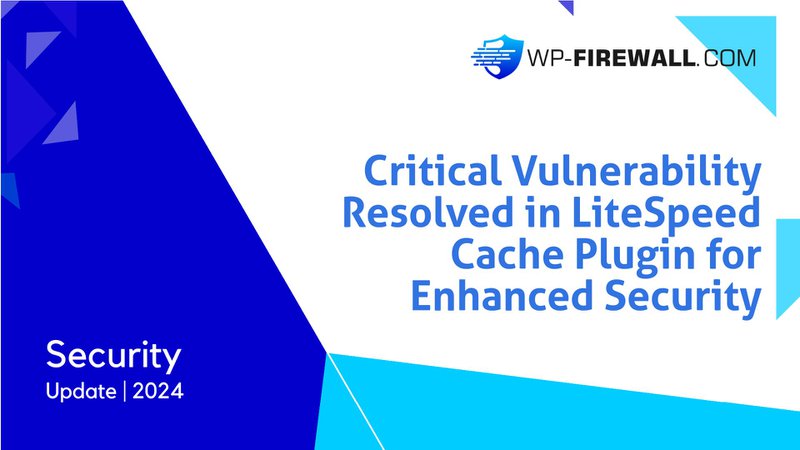
Proteggere il tuo sito WordPress dalle vulnerabilità di escalation dei privilegi
Nel panorama in continua evoluzione della sicurezza di WordPress, le recenti vulnerabilità hanno evidenziato l'importanza di misure di difesa proattive. Una di queste vulnerabilità critiche è stata recentemente corretta nel plugin LiteSpeed Cache, colpendo oltre 5 milioni di siti. Questo articolo approfondirà i dettagli di questa vulnerabilità e come è stata sfruttata, oltre a fornire approfondimenti su come proteggere il tuo sito WordPress da minacce simili.
La vulnerabilità nel plugin LiteSpeed Cache
Il plugin LiteSpeed Cache, un popolare strumento di caching e ottimizzazione per WordPress, ha sofferto di una grave vulnerabilità di escalation dei privilegi (CVE-2024-28000). Questa vulnerabilità ha consentito ad aggressori non autenticati di falsificare il proprio ID utente e ottenere l'accesso a livello di amministratore sfruttando la verifica hash debole ricavata dai cookie del browser quando si chiamava l'API REST "utenti" di WordPress.
Come è stata sfruttata la vulnerabilità
La vulnerabilità era radicata nell'implementazione della funzionalità di simulazione dei ruoli del plugin. In particolare, il gestore_velocità_asincrono() la funzione non aveva controlli nonce appropriati, rendendo possibile agli utenti non autenticati di attivare la funzione e generare un hash di sicurezza. Questo hash è stato quindi utilizzato per simulare una scansione e potenzialmente ottenere l'accesso ai ruoli amministrativi.
Correggere la vulnerabilità
Per risolvere questo problema, il team di LiteSpeed ha implementato diverse misure di sicurezza:
- Validazione hash: Il team ha aggiunto la convalida hash utilizzando
hash della chiamata asincronavalore dell'opzione nelRouter::async_litespeed_handler()funzione. - Hash monouso: Un controllo hash aggiuntivo,
hash_flash_di_litespeed, è stato introdotto con un TTL di 120 secondi. - Generazione hash sicura: La lunghezza degli hash di sicurezza è stata aumentata a 32 caratteri casuali per
hash della chiamata asincrona,hash_flash_di_litespeed, Ehash_di_velocità. - Simulazione del ruolo del crawler: Il codice ora genera un nuovo hash ogni volta che viene eseguito il crawler e memorizza l'IP della richiesta corrente per la convalida.
Punti chiave
- Difesa proattiva: Affidarsi esclusivamente alle patch ufficiali può lasciare una finestra di vulnerabilità. Misure di difesa proattive come soluzioni di protezione in tempo reale sono essenziali per mantenere il tuo sito sicuro.
- Verifica hash debole: L'uso di meccanismi di verifica hash deboli può essere sfruttato dagli aggressori. Garantire la forza e l'imprevedibilità degli hash di sicurezza è fondamentale.
- Aggiornamenti dei plugin: Aggiornare regolarmente i plugin è fondamentale per correggere le vulnerabilità note prima che possano essere sfruttate.
Proteggere il tuo sito WordPress
Per proteggere il tuo sito WordPress da vulnerabilità simili:
- Mantieni i plugin aggiornati: Aggiornare regolarmente tutti i plugin, in particolare quelli con numeri di installazione elevati come LiteSpeed Cache.
- Utilizzare la protezione in tempo reale: Implementare soluzioni di protezione in tempo reale in grado di rilevare e bloccare gli exploit non appena si verificano.
- Monitorare gli aggiornamenti: Segui gli aggiornamenti di sicurezza e le patch degli sviluppatori di plugin e del core di WordPress.
- Utilizzare hash sicuri: Assicurarsi che tutte le funzionalità relative alla sicurezza utilizzino hash forti e imprevedibili.
Conclusione
La recente vulnerabilità nel plugin LiteSpeed Cache serve a ricordare l'importanza di misure di sicurezza robuste in WordPress. Restando proattivi e mantenendo il tuo sito aggiornato con le ultime patch, puoi ridurre significativamente il rischio di compromissione. Ricorda, la difesa proattiva è essenziale per proteggere il tuo sito WordPress dalle minacce emergenti.
Inizia a proteggere il tuo WordPress
Considerata la minaccia sempre presente delle vulnerabilità legate all'escalation dei privilegi, è fondamentale disporre di una soluzione di sicurezza solida. WP-Firewall offre funzionalità di sicurezza avanzate progettate per proteggere il tuo sito WordPress da varie minacce, tra cui gli attacchi di escalation dei privilegi.
Perché hai bisogno del piano WP-Firewall PRO:
- Protezione in tempo reale: WP-Firewall fornisce protezione in tempo reale contro gli exploit, garantendo la sicurezza del tuo sito anche prima che siano disponibili le patch ufficiali.
- Regole personalizzabili: Crea regole firewall personalizzate per bloccare richieste specifiche e proteggerti dalle vulnerabilità note.
- Registrazione avanzata: La registrazione dettagliata aiuta a monitorare e analizzare il traffico, facilitando il rilevamento di potenziali minacce.
- Aggiornamenti regolari: Il nostro team aggiorna costantemente il plugin con le ultime patch di sicurezza e funzionalità.
Iscriviti al piano gratuito di WP-Firewall da https://my.wp-firewall.com/buy/wp-firewall-free-plan/
- Protezione di base: Inizia con il nostro piano gratuito per ottenere una protezione di base contro le minacce più comuni.
- Aggiorna più tardi: Se hai bisogno di funzionalità più avanzate, puoi facilmente passare al nostro piano PRO.
Iscriviti alla nostra newsletter sulla sicurezza:
- Rimani informato: Rimani aggiornato sulle ultime novità e suggerimenti sulla sicurezza iscrivendoti alla nostra newsletter sulla sicurezza.
- Prova gratuita di 15 giorni: Prova gratuitamente per 15 giorni il nostro abbonamento alla newsletter per scoprire come può migliorare la sicurezza del tuo sito.
Non aspettare che sia troppo tardi. Proteggi il tuo sito WordPress oggi stesso con WP-Firewall. Visita WP-Firewall per saperne di più e iniziare subito a proteggere il tuo sito.

